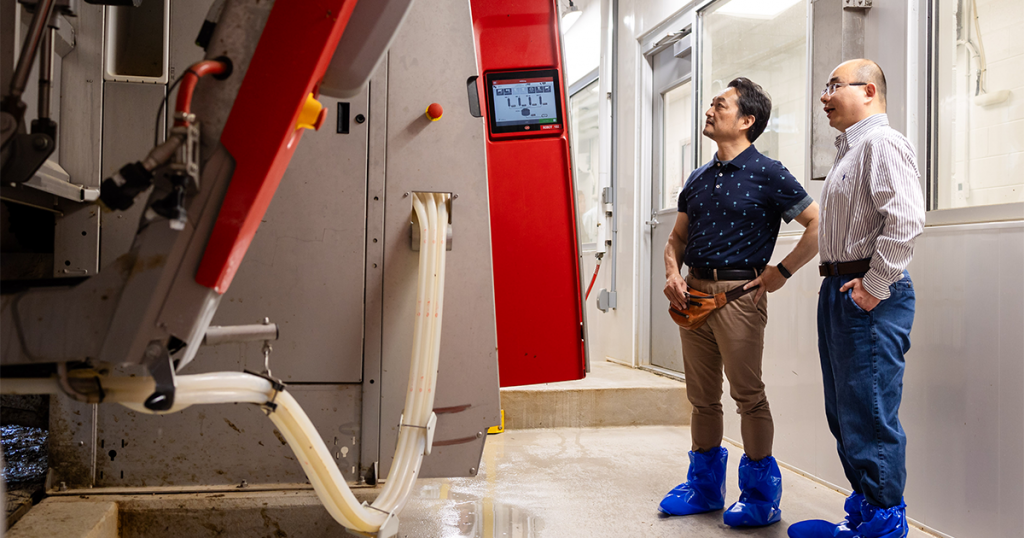Bovine mastitis, or udder inflammation, is the most economically and biologically significant disease affecting dairy cows. Since it can be caused by more than 20 species of microorganism, it is also one of the hardest to detect and manage.
Mastitis lowers a cow’s milk yield and quality, causes animal distress, and can be fatal—and if the infection is not detected and treated early, the disease can spread rapidly.
“In 2014, we asked how we can best help dairy farmers,” said Jayne Wu, a professor in the Min H. Kao Department of Electrical Engineering and Computer Science (EECS). “It turned out early mastitis detection was the most sought-after solution.”
Wu, a specialist in microfluidics and biosensing, has been working on bovine disease detection for more than a decade. In 2009, she and UT Institute of Agriculture (UTIA) professor Shigetoshi Eda began developing a handheld device to help dairy farmers quickly identify diseases affecting their cattle.


Wu and Eda have continued working on their AiCap biosensor ever since. EECS Gonzalez Family Professor Hairong Qi, an expert in artificial intelligence (AI) and pattern recognition, has helped improve the device’s accuracy in interpreting the noisy data that often results when readings are taken outside the laboratory.
The AiCap biosensor can now identify many chemicals and disease-causing microbes, including pseudorabies, bovine tuberculosis, and even human influenza.
The Internet of Things Simplifies Farm Management
Meanwhile, EECS Associate Professor Charles Cao has been working on bringing networks of small, locally connected devices, known as the Internet of Things (IoT), to dairy farm management.
“We want to simplify the workflow of herd management and make it more efficient,” Cao said. “Agriculture has been making a lot of progress through the integration of techniques such as sensing, AI, and analytics, but applying IoT networks to dairy farms is something new.”
As soon as he learned about the AiCap biosensor, Cao saw that integrating it with devices like GPS ear tags and cow body temperature sensors would give farmers the ability to predict how disease could spread through a herd—and an unprecedented opportunity to nip outbreaks in the bud.
Social Networking for Disease Control
In 2023, Wu, Eda, Qi, and Cao received a $1 million grant from the National Institute of Food and Agriculture (NIFA) to create an IoT network that could identify, track, and inform management of diseases in dairy herds.
“We use IoT devices to track the behavior and location of each cow, which lets us build a kind of social interaction network,” Cao said. “Then, if a cow gets a disease, we use the network’s history to predict which other cows are most likely to be affected.”

The study is being conducted at UT’s Little River Unit research dairy farm, where cows are divided evenly between conventional milking and a state-of-the-art milking facility that gathers biological data on the animals and tracks the quality and quantity of their milk. Wu, Eda, Qi, and Cao are also working on an in-line white blood cell counter to identify cows sick with subclinical, or asymptomatic, mastitis.
Cows with clinical, or symptomatic, mastitis might lie down more than usual, as revealed by positional monitors, or move less often and more slowly, as indicated by GPS data.
When cows with either biological or behavioral signs of disease are identified by the system, farm managers can isolate them and use the AiCap biosensor to identify the mastitis-causing microorganism. They can then form an action plan for treatment—and, critically, isolate other cows that are likely to be infected.
“Integrating these technological advances for early disease detection and management helps improve biosecurity, food safety and quality, and food chain security,” Cao said.
Digital Twins Enable Long-Term Planning
While their combined IoT and biosensor workflow is already highly effective for real-time disease detection and management, the professors want to help farmers manage future scenarios too.
By aggregating the ever-increasing amount of data about the networked farm, the researchers can create its “digital twin”—a customized model that can be used to simulate how future diseases could spread and respond to different management methods. Economic parameters included in the twin, like the projected future cost of laborers, feed, and milk, can be used to find methods that are both effective and economical.




“This project takes advantage of the collaborations between the Tickle College of Engineering, especially the EECS department, and UTIA,” Cao said. “We are combining faculty expertise on hardware, AI, veterinary medicine, and farm management. The multidisciplinary team we formed has been instrumental in pushing this project forward.”
Due to the low cost of the IoT sensors and the AiCap biosensor, Wu is hopeful that the project will soon be able to expand to other types of farms, like poultry farms and commercial dairies.
“Though we developed it for dairy farms, our technology can be applied to many different scenarios,” she said.
Contact
Izzie Gall (865-974-7203, egall4@utk.edu)
